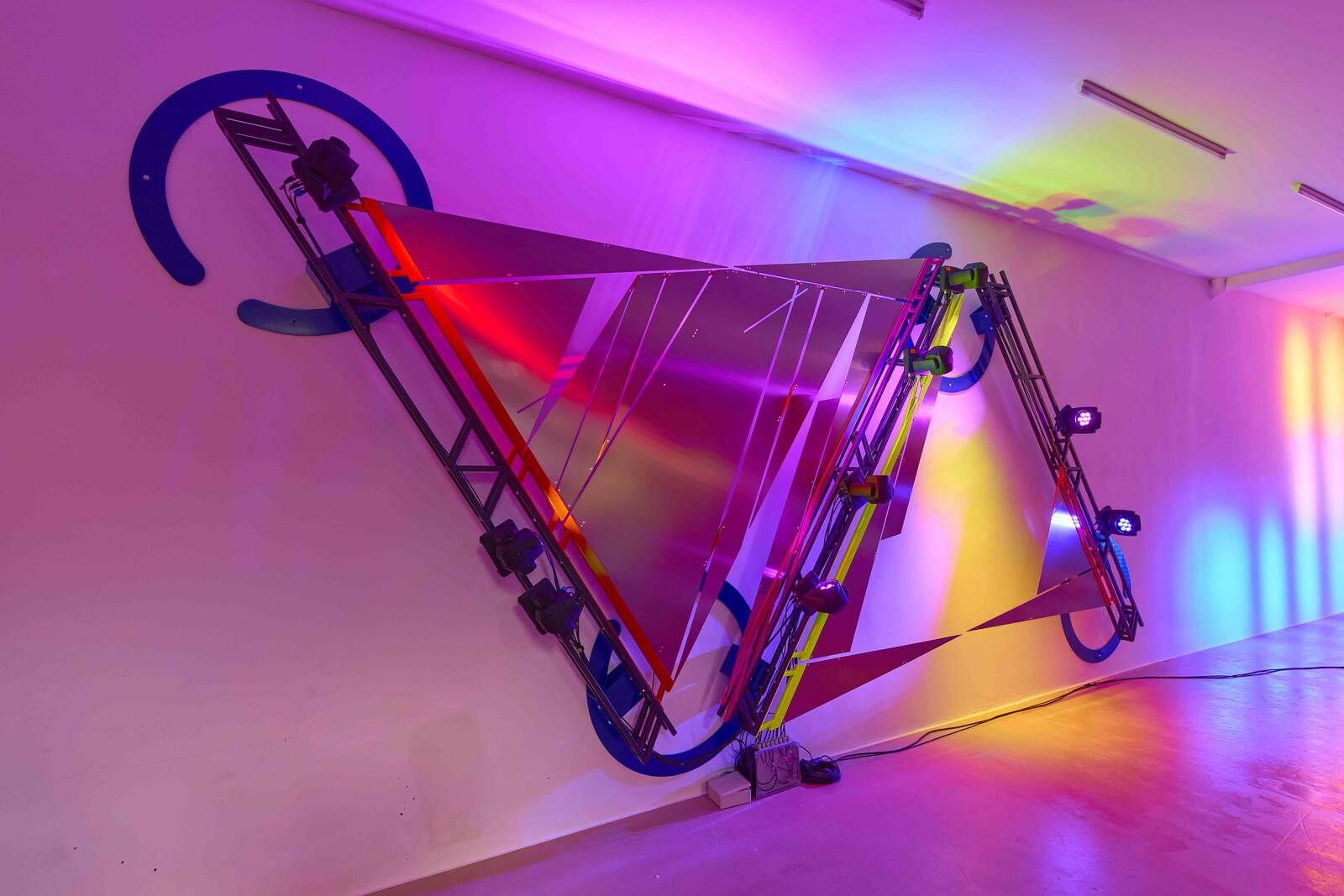Techno Zen
April 20–November 24, 2024
Giardini
Venice
Italy
Márton Nemes’s work is influenced by techno subcultures; the explosion and rearrangement of the pictorial field gives a psychedelic character to his abstract paintings that evoke the visual atmosphere of today’s nightclubs. Combining painterly and sculptural elements, his multimedia installations create a hypnotic spatial dynamic that propels the viewer from the harsh, real world into a fluid, dizzying, fluorescent colour field.
For the 60th International Venice Biennale, Nemes designed the project as an immersive, painting-based Gesamtkunstwerk that expands the genre of painting and extends it to other media. The term techno also refers to techné and technological art; the fusion of industrial technologies and materials with a more conventional approach unfolds as a painting-object, an installation or a moving painterly environment. Laser-cut steel, car paint, enamelled steel plate, projection, DMX lights, speakers and coloured fans are the tools Nemes integrates in his practice in order to reinterpret the palette of painting. By doing so, he creates a multisensory environment: its optical, acoustic and haptic content unfolds through the combined effects of light, colour, movement and sound. Thus, the vibrancy of techno transforms into a Zen resonance.
The exhibition is structured in three main parts; their joint, overall effect is meant to be fully understood, perceived and experienced when the visitor stands in the middle of the pavilion, the courtyard that links all spaces. This position—being in the middle—carries a symbolic meaning; it is both physical and ontological. In an era of extremely polarised societal phenomena that lack or completely exclude nuances, the project conveys a humanistic message that advocates for openness and tolerance.
Published by the Ludwig Museum—Museum of Contemporary Art Budapest for this occasion, the catalogue features the contributions of art historians and curators Loránd Hegyi, David Rosenberg and Anika Meier.
About Márton Nemes
Márton Nemes (b. 1986, Székesfehérvár) first studied industrial design at the Budapest Technical University, then continued his studies at the Department of Painting of the Hungarian University of Fine Arts in 2013, and graduated in 2018 with a master’s degree from Chelsea College of Arts, London. A year later, he was awarded the prestigious Esterházy Art Award for emerging artists. His work has been exhibited in several European galleries (acb Gallery, Budapest; Fold Gallery, London; Annka Kultys Gallery, London, 193 Gallery, Paris and Erika Deák Gallery, Budapest) as well as public institutions in Hungary. He has participated in such international exhibitions as Haunting Monumentality at MSU Zagreb (2014), Falling Out the Rythm at BWA Warsaw (2019), Abstract Hungary at Künstlerhaus—Halle für Kunst und Medien in Graz (2017), as well as Place Value—New Acquisitions at Ludwig Museum—Museum of Contemporary Art in Budapest (2022) and New Mediations at Modem in Debrecen (2022-2023).His works are part of numerous Hungarian and international, private and public collections. He is represented by acb Gallery (Budapest) and Double Q Gallery (Hong Kong). In 2024, he founded the Kazinczy 51 Art Hub. He lives and works in New York and Budapest.
About Róna Kopeczky
Róna Kopeczky (b. 1983, Grenoble, France) is a curator and art historian based in Budapest since 2004. Between 2006 and 2015 she was curator at the Ludwig Museum—Museum of Contemporary Art in Budapest. Since 2015, she has been the artistic director of acb Gallery in Budapest. She is co-founder and co-leader of Easttopics, a platform dedicated to representing the Central and Eastern European contemporary art scene.
National Commissioner: Julia Fabényi
Curator: Róna Kopeczky
Organizer: Ludwig Museum—Museum of Contemporary Art
Venue: Giardini
Press office
Gabriella Rothman, T +36 20 3314033 / rothman.gabriella [at] ludwigmuseum.hu
Zsuzsanna Fehér, T +36 30 6190710 / feher.zsuzsanna [at] ludwigmuseum.hu
High resolution images and press release can be downloaded here.
Supported by the Hungarian Ministry of Culture and Innovation.



